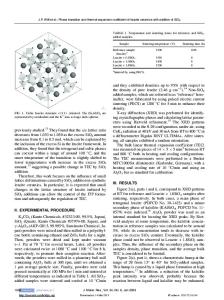Influence of Temperature on the Coefficient of Thermal Expansion of Monocrystals of Silicon
- PDF / 337,394 Bytes
- 7 Pages / 612 x 792 pts (letter) Page_size
- 111 Downloads / 391 Views
INFLUENCE OF TEMPERATURE ON THE COEFFICIENT OF THERMAL EXPANSION OF MONOCRYSTALS OF SILICON A. V. Mazur 1 and L. P. Stepanova 2
UDC 669.13:669.715
Using specimens of monocrystalline silicon with strict crystallographic orientation and insignificant (1.5° ) off-orientation, we have studied changes in the value (up to 400%) and sign of the coefficient of thermal expansion for the crystallographic directions 〈 111 〉, 〈 110 〉, and 〈 112 〉. Experiments were carried out under conditions of permanent change in the temperature from 32 3 to 1473 K and under normal pressure. We have corroborated that the monomorphism of silicon (Fd3m, i.e., a diamond-type lattice) is retained over the entire temperature range. Specimens of crystallographic direction 〈 110 〉 are much less subjected to the influence of changes in the temperature than the others.
With increase in the working temperatures of electronic chips, silicon monocrystalline substrates, microsprings made of monocrystalline silicon, and other microarticles, the frequency of failures of electronic circuits grows. One of the causes of this phenomenon is connected with the self-destruction of articles or their detachment from the substrate material [1]. To produce these articles, it is customary to use monocrystalline silicon with cutting of the plates along the planes {111} or {100} [2]. However, in many cases, the influence of cutting and crystallographic off-orientation of articles on their thermomechanical characteristics is not taken into account. As established in recent investigations [3, 4], polymorphic phase transformations can take place in monocrystalline silicon with change in the temperature under normal pressure. They were recorded by the temperature dependence of the coefficient of thermal expansion (CTE), and the polymorphic types of silicon crystal lattices were identified by the appearance of additional maxima in X-ray diffractograms at temperatures higher than 553 K. The aim of the present work is to investigate the thermal expansion of monocrystalline silicon in a wide temperature range depending on the crystallographic orientation in order to determine the thermomechanical compatibility of monocrystals of silicon with the components of electronic devices. Material and Experimental Procedure We studied a monocrystal of silicon of semiconductor purity, grown by the Czochralski method on a monocrystalline substrate with cutting {111}. It represented a cylindrical rod with axis [111] 50 mm in height and 16 mm in diameter, cut along its generating line by the natural crystallographic planes of an octahedron. We determined the orientation of crystallographic planes and directions in the monocrystal by the Laue method of inverse shooting with the obtaining of epigrams. The photographic film was located in front of the crystal transversely to the primary beam at a distance of 40.5 mm from the surface of the crystal. The epigrams were interpreted using the standard procedure [5]. 1 Helsinki University of Technology, Helsinki, Finland. 2 Zaporizhzhya National T
Data Loading...







